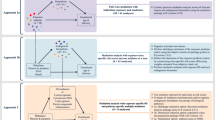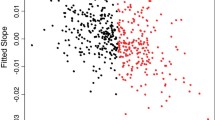Abstract
Exposure to developmental toxicants may cause foetal malformations, increase foetal death or resorption and reduce foetal weight. The correlations among these developmental endpoints have been reported, but their causal relationships have not been investigated. Structural equation models (path models) were applied to study the patterns of causation among the four developmental outcomes, number of viable foetuses, number of malformations, number of deaths/resorptions, and average foetal weight; these outcomes were modelled as response variables with the dose level and number of implants (litter size) modelled as independent variables. Three hypothesized path models were fitted to developmental toxicity data from a study of the herbicide 2,4,5-T exposure in mice. One model, which hypothesized that foetal weight, implicitly a mechanism such as cellular growth, affects both malformations and death/resorption (equivalently, viability) with no causation relationship between malformation and death/resorption, described data consistently well for three strains of mice. The most consistent relationship found was a strong direct effect of foetal weight on malformations, and the correlation between malformations and death/resorption (or reduced viability) was likely spurious.
Similar content being viewed by others
References
Barr, M., Jr., Jensh, R.P. and Brent, R.L. (1969) Fetal weight and intrauterine position in rats. Teratology, 2, 241–6.
Catalano, P.J. and Ryan, L.M. (1992) Bivariate latent variable models for clustered discrete and continuous outcomes. Journal of the American Statistical Association, 87, 651–8.
Chen, J.J. (1993) A malformation incidence dose response model incorporating foetal weight and/or litter size as covariates. Risk Analysis, 13, 559–64.
Chen, J.J. and Gaylor, D.W. (1992) Correlations of developmental end points observed after 2,4,5-trichlorophenoxyacetic acid exposure in mice. Teratology, 45, 241–6.
Chen, J.J. and Kodell, R.L. (1989) Quantitative risk assessment for teratological effects. Journal of the American Statistical Association, 84, 966–71.
Chen, J.J., Kodell, R.L., Howe, R.B., and Gaylor, D.W. (1991) Analysis of trinomial responses from reproductive and developmental toxicity experiments. Biometrics, 47, 1049–58.
Cornwall, G.A., Carter, M.W., and Bradshaw, W. S. (1984) The relationship between prenatal lethality or fatal weight and intrauterine position in rats exposed to diethylstilbestrol, zeranol, 3,4,3′,4′-tetrachlorobi-phenyl, or cadmium. Teratology, 30, 341–9.
Fitzmaurice, G.M. and Laird, N.M. (1995) Regression models for a bivariate discrete and continuous outcome with clustering. Journal of the American Statistical Association, 90, 845–52.
Freni, S.C. and Zapisek, W.F. (1991) Biologic basis for risk assessment model for cleft palate. Cleft PalateCraniofacial Journal, 28, 338–46.
Gaylor, D.W. and Chen, J.J. (1993) Dose-response models for developmental malformations. Teratology, 47, 291–7.
Gladen, B. (1979) The use of jackknife to estimate proportions from toxicological data in the presence of litter effects. Journal of the American Statistical Association, 74, 1049–58.
Haseman, J.K. and Hogan, M.D. (1975) Selection of the experimental unit in teratology studies. Teratology, 12, 165–72.
Holson, J.F., Gaines, T.B., Nelson, C.J., LaBorde, J.B., Gaylor, D.W., Sheehan, D.M, and Young, J.F. (1992) Developmental toxicity of 2,4,5-trichlorophenoxyacetic acid 1: Dose-response studies in four inbred strains and one outbred stock of mice. Fundamental and Applied Toxicology, 19, 286–97.
Jensh, R.P., Brent, R.L. and Barr, M. Jr. (1970) The litter effect as a variable in teratologic studies of the albino rat. American Journal of Anatomy, 128, 185–92.
Kimmel, C.A. and Gaylor, D.W. (1988) Issues in qualitative and quantitative risk analysis for developmental toxicology. Risk Analysis, 8, 15–19.
Kimmel, C.A., Kimmel, G.L., and Frankos V. (eds.) (1986) IRLG workshop on reproductive toxicity human risk assessment. Environmental Health Perspective, 66, 193–221.
Lefkopoulou, M., Moore, D., and Ryan, L.M. (1989) The analysis of multiple correlated binary outcomes: application to rodent teratology experiments. Journal of the American Statistical Association, 84, 810–15.
Loehlin, J.C. (1987) Latent Variable Models: An Introduction to Factor, Path and Structural Analysis. Lawrence Erlbaum Associates, Hillsdale, NJ.
Rai, K. and Van Ryzin, J. (1985) A dose-response model for teratological experiments involving quantal responses. Biometrics, 41, 1–9.
Ryan, L.M. (1992) Quantitative risk assessment for developmental toxicity. Biometrics, 48, 163–74.
Ryan, L.M., Catalano, P.J., Kimmel, C.A., and Kimmel, G.L. (1991) On the relationship between foetal weight and malformation in developmental toxicity studies. Teratology, 44, 215–23.
Williams, D.A. (1975) The analysis of binary responses from toxicological experiments involving reproduction and teratogenicity Biometrics, 31, 949–52.
Author information
Authors and Affiliations
Rights and permissions
About this article
Cite this article
Chen, J.J., Lensing, S. Causal modelling of multivariate outcomes from developmental toxicity experiments. Environ Ecol Stat 3, 207–218 (1996). https://doi.org/10.1007/BF00453010
Received:
Revised:
Issue Date:
DOI: https://doi.org/10.1007/BF00453010




